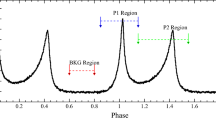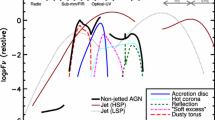Abstract
The photometric UBV observations of AS 338 that we began after its outburst in 1983 are presented. They were accompanied by yearly spectroscopic observations and by occasional estimations of the star’s infrared JHKL magnitudes. In June 1993, the star’s optical spectrum was extended to the ultraviolet via IUE observations of AS 338. Collectively, the above observations make it possible to trace the evolution of stellar activity over a period of 15 years in various spectral ranges. In particular, a short-time return of the hot component of AS 338 to the state when He II lines reappeared in the star’s spectrum was noted in 1993. At this time, a blend of the C IV λλ5802 and 5812 lines, which is typical of Wolf-Rayet spectra, was detected in it. In June 1993, the temperature of the hot component was T h ≈ 8.8 × 104 K, and the ratio of its bolometric flux to that of the red giant was F h, bol/F g, bol ≈ 1.0. In August, its temperature increased to ∼1.0×105 K, while the bolometric flux dropped by a factor of ∼1.5(F h, bol/F g, bol ≈ 0.7). In the B-V, U diagram, the points referring to this so-called quiescent state form a separate group shifted in B-V from all the remaining ones located in a horizontal strip with \(\Delta U \approx 3\mathop .\limits^m 5\) and \(\Delta (B - V) \approx 0\mathop .\limits^m 4\). This allows us to diagnose the state of the hot component without spectroscopic observations of the star. In October 1993, the hot component flared up again. The main brightness rise took no more than 19 days. The outburst occurred shortly before eclipse egress of the hot component, whose duration was ∼0.01P orb. In December 1993, F h, bol/F g, bol≤1.5 at maximum light. During the recurrent, even stronger outburst in April 1995, F h, bol/F g, bol≤3.4. The Hαline during outbursts has a P Cyg profile and broad wings stretching to velocities of ±1500 km s−1. The color temperature of the active hot component at short optical wavelengths and in the ultraviolet lies in the range of effective temperatures for hot supergiants. Nevertheless, it always produces an H II region in the circumstellar envelope that is larger in size than this binary system.
Similar content being viewed by others
References
P. W. Merril and C. G. Burwell, Astrophys. J. 112, 72 (1950).
D. A. Allen, Proc. Astron. Soc. Austral. 5, 369 (1984).
R. Schulte-Ladbeck, Messenger 39, 3 (1985).
U. Munari, Astron. Astrophys. 257, 163 (1992).
U. Munari, B. F. Yudin, G. Sostero, et al., IAU Circ. No. 5884 (1993).
U. Munari, T. Tomov, B. Yudin, et al., IAU Circ. No. 6151 (1995).
F. Elizalde, F. Jablonski, D. Cieslinski, et al., IAU Circ. No. 6165 (1995).
N. E. Kurochkin, Private Communication (1999).
V. F. Esipov, O. G. Taranova, and B. F. Yudin, Astrofizika 29, 285 (1988).
T. Fernández-Castro, R. Gonzá-Riestra, A. Cassatella, et al., Astrophys. J. 442, 366 (1995).
J. Mikolajewska and S. J. Kenyon, Astron. J. 112, 1659 (1996).
A. Skopal, L. Vittone, L. Ericco, et al., Mon. Not. R. Astron. Soc. 292, 703 (1997).
V. F. Esipov, A. P. Ipatov, and B. F. Yudin, Astrofizika 25, 229 (1986).
J. Mikolajewska, A. Acker, and B. Stenholm, Astron. Astrophys. 327, 191 (1997).
T. A. Lee, Astrophys. J. 162, 217 (1970).
J. Koorneef, Astron. Astrophys., Suppl. Ser. 51, 489 (1983).
D. M. Terndrup, J. A. Frogel, and A. E. Whitford, Astrophys. J. 357, 453 (1990).
D. A. Allen, Mon. Not. R. Astron. Soc. 192, 521 (1980).
A. A. Boyarchuk, Eruptive Stars (Nauka, Moscow, 1976), p. 113.
A. P. Ipatov and B. F. Yudin, Astron. Tsirk., No. 1471, 4 (1986).
F. P. Ipatov and B. F. Yudin, Astrofizika 25, 435 (1986).
B. F. Yudin, Astron. Zh. 63, 137 (1986).
A. Cassatella, T. Fernández-Castro, R. Gonzá-Riestra, et al., Astron. Astrophys. 258, 368 (1992).
U. Munari, E. A. Kolotilov, A. A. Popova, et al., Astron. Zh. 74, 898 (1997).
T. S. Belyakina, Izv. Krymsk. Astrofiz. Obs. 59, 133 (1979).
E. A. Kolotilov, U. Munari, and B. F. Yudin, Mon. Not. R. Astron. Soc. 275, 185 (1995).
T. Tomov, D. Kolev, U. Munari, et al., Mon. Not. R. Astron. Soc. 278, 542 (1996).
Author information
Authors and Affiliations
Additional information
__________
Translated from Pis’ma v Astronomicheski\(\overset{\lower0.5em\hbox{$\smash{\scriptscriptstyle\smile}$}}{l}\) Zhurnal, Vol. 26, No. 3, 2000, pp. 200–216.
Original Russian Text Copyright © 2000 by Esipov, Kolotilov, Mikolajewska, Munari, Tatarnikova, Tatarnikov, Tomov, Yudin.
Rights and permissions
About this article
Cite this article
Esipov, V.F., Kolotilov, E.A., Mikolajewska, J. et al. Evolution of the symbiotic star AS 338 after its strong outburst in 1983. Astron. Lett. 26, 162–176 (2000). https://doi.org/10.1134/1.20379
Received:
Issue Date:
DOI: https://doi.org/10.1134/1.20379




